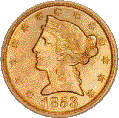Mean of Binomial Distribution

A binomial distribution represents the results from a simple experiment where there is “success” or “failure.” For example, if you are polling voters to see who is voting Democrat, the voters that say they will vote Democrat is a “success” and anything else is a failure. One of the simplest binomial experiments you can perform is a coin toss, where “heads” could equal “success” and “tails” could equal “failure.”
The mean of binomial distribution is much like the mean (i.e. the average) of anything else. It answers the question “If you perform this experiment many times, what’s the likely (the average) result?.
Formula for Mean of Binomial Distribution
The formula for the mean of binomial distribution is:
μ = n *p
Where “n” is the number of trials and “p” is the probability of success.
For example: if you tossed a coin 10 times to see how many heads come up, your probability is .5 (i.e. you have a 50 percent chance of getting a heads and 50 percent chance of a tails) and “n” is how many trials — 10. Therefore, the mean of this particular binomial distribution is:
10 * .5 = 5.
This makes sense: if you toss a coin ten times you would expect heads to show up on average, 5 times.
Check out our YouTube channel for hundreds of help videos for elementary statistics!